
Senecio is a genus of the daisy family (Asteraceae) that includes ragworts and groundsels. The scientific Latin genus name, Senecio, means "old man."

Ganna Walska Lotusland, also known as Lotusland, is a non-profit botanical garden located in Montecito, near Santa Barbara, California, United States. The garden is the historic estate of Madame Ganna Walska. The County of Santa Barbara restricts visitation via a conditional use permit: Lotusland botanic garden is open to the public by advance reservation only, with walking tours 1½ to 2 hours long.
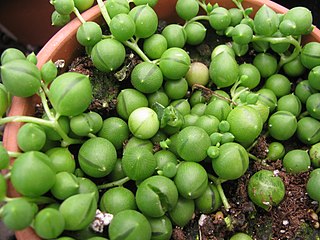
Curio rowleyanus, syn. Senecio rowleyanus, is a flowering plant in the daisy family Asteraceae. It is a creeping, perennial, succulent vine native to the drier parts of southwest Africa. In its natural environment its stems trail on the ground, rooting where they touch and forming dense mats. It often avoids direct sunlight by growing in the shade of other plants and rocks. It is commonly known as string-of-pearls or string-of-beads.

Senecio angulatus, also known as creeping groundsel and sometimes as Cape ivy, is a succulent plant from the family Asteraceae of the genus Senecio that is native to South Africa. It is a scrambling and a twining herb that can become an aggressive weed once established, making it an invasive species in some countries. However, it is grown as an ornamental plant for its satiny foliage and sweet-scented flowers.

Senecio crassissimus, also known as lavender steps, vertical leaf, and propeller plant, is a succulent species of the genus Senecio, family Asteraceae and endemic to Madagascar.
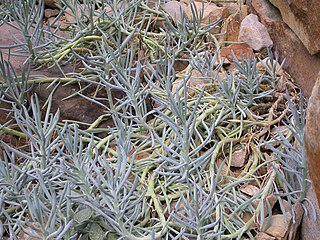
Curio ficoides, syn. Senecio ficoides, also known as skyscraper Senecio and Mount Everest Senecio, is a species of succulent plant, in the genus Curio (Asteraceae), indigenous to South Africa.

Curio archeri, syn. Senecio toxotis is a species of succulent plant in daisy family that is indigenous to the south-western Cape, South Africa.
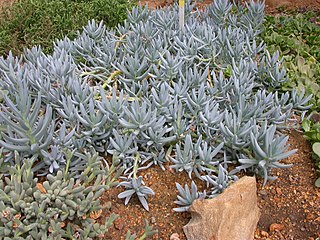
Curio repens, syn. Senecio serpens, is a species of the genus Curio in the Asteraceae family. A succulent endemic to the Western Cape province of South Africa, it is typically found growing from crevices in rocky sandstone slopes. Commonly named blue chalksticks, it is used as an ornamental plant.

The Huntington Desert Garden is part of The Huntington Library, Art Collections and Botanical Gardens in San Marino, California. The Desert Garden is one of the world's largest and oldest collections of cacti, succulents and other desert plants, collected from throughout the world. It contains plants from extreme environments, many of which were acquired by Henry E. Huntington and William Hertrich in trips taken to several countries in North, Central and South America. One of the Huntington's most botanically important gardens, the Desert Garden brought together a group of plants largely unknown and unappreciated in the beginning of the 1900s. Containing a broad category of xerophytes, the Desert Garden grew to preeminence and remains today among the world's finest, with more than 5,000 species in the 10 acre garden.
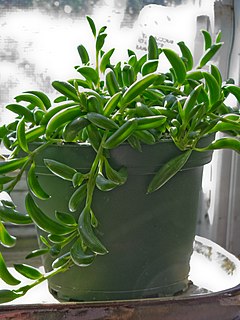
Curio radicans, syn. Senecio radicans, is a succulent houseplant that is native to South Africa. A member of the family Asteraceae, the asters, this species is closely related to the common String of Pearls and Curio hallianus. It has multiple tendrils of glossy, banana-shaped foliage. It is commonly known as string of bananas.
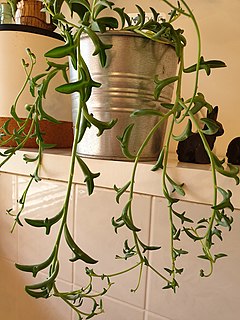
Curio × peregrinus, also known as dolphin necklace, flying dolphins, string of dolphins, dolphin plant or Senecio hippogriff, is a succulent nothospecies of Curio in the family Asteraceae. It is often called, incorrectly, Senecio peregrinus, but that name was previously given, by Grisebach in 1879, to a different species from South America. The name Curio × peregrinus was published in 1999, based on the earlier name Kleinia peregrina; however, this name was not validly published. The plant is a hybrid between Curio rowleyanus and Curio articulatus.

Curio is a genus of flowering plant in the family Asteraceae. Plants in the genus are evergreen succulents with long, striated leaves and discoid flower heads lacking ray florets.

Curio articulatus, syn. Senecio articulatus, which is also known as candle plant, pickle plant and hot dog cactus, is a deciduous succulent plant that is native to South Africa.

Curio herreanus, syn. Senecio herreanus, which is also known as string of watermelons, string of beads, gooseberry plant and string of raindrops, is a flowering succulent plant in the daisy family Asteraceae that is native to South Africa. It is grown as an ornamental plant and is very similar in appearance to 'string of pearls', where the names may be conflated.

Curio talinoides, syn. Senecio mandraliscae, also known as blue straws, blue chalksticks, dassieharpuis, or narrow-leaf chalk sticks, is a succulent plant of the sunflower family that is native to South Africa. The origin of this plant is dubious and it may be a hybrid.

Curio crassulifolius, also known as blue fingers, is a succulent in the sunflower family that is native to South Africa.
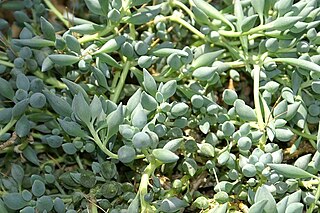
Curio citriformis, syn. Senecio citriformisis, also known as string of tears, is a trailing succulent plant in the sunflower family native to South Africa that grows in rocky outcrops in clay soils.

Curio hallianus, syn. Senecio hallianus, is a creeping succulent plant in the daisy family Asteraceae that is native to South Africa.

Curio muirii is a succulent plant in the daisy family that is native to South Africa.

Gordon Douglas Rowley (1921–2019) was a British botanist and writer specialising in cacti and succulents.




















